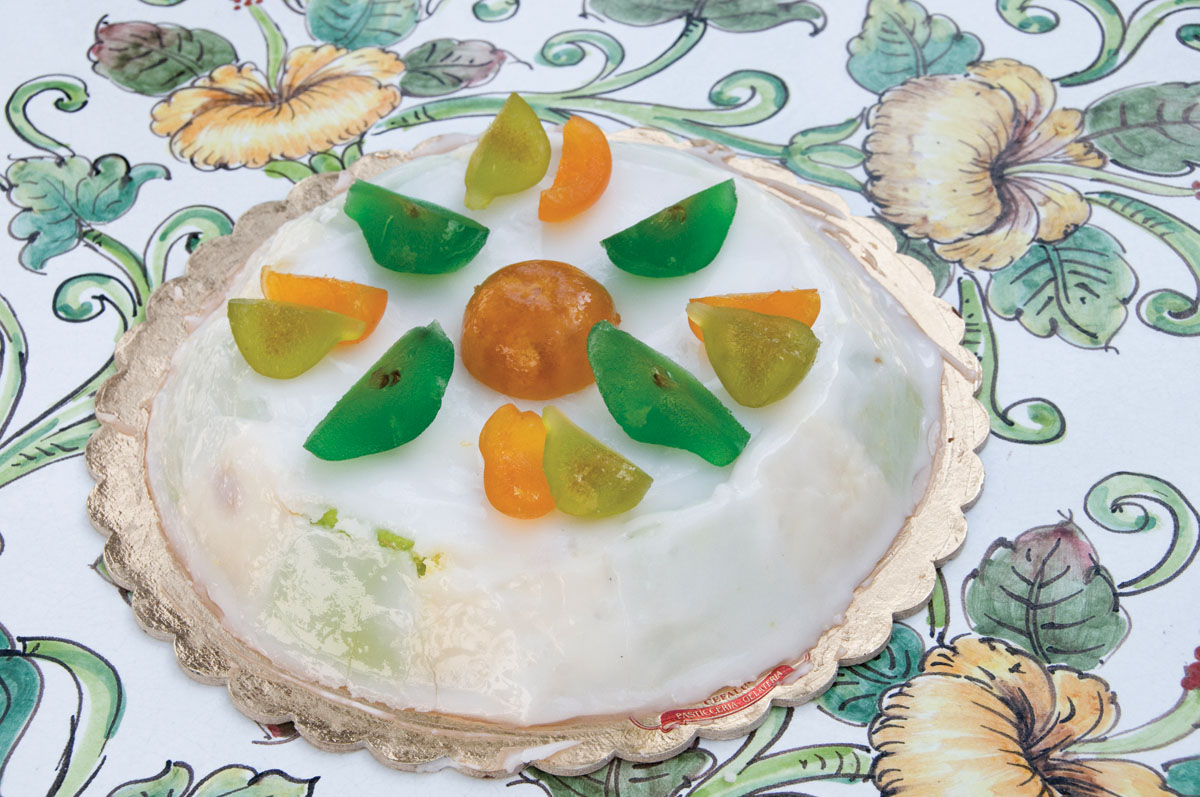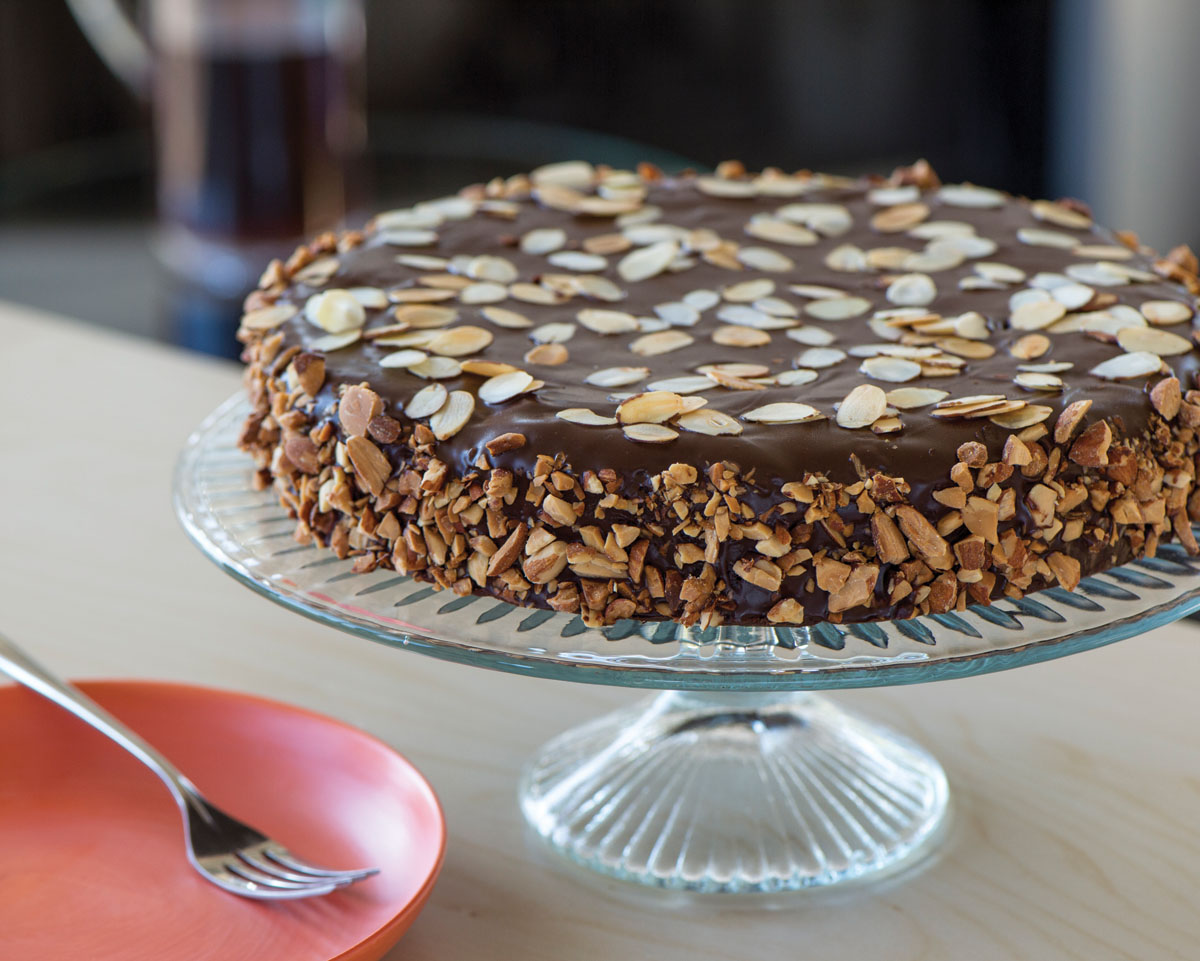
Almond Flour Bread
This dough yields a mild golden loaf with a subtle nutty flavor and a tight crumb due to the addition of almond flour. Use as a sandwich bread, serve thinly sliced and toasted with preserves and butter, or cube and panfry in oil for croutons.
| 4 cups (570 g) bread flour |
| 1 cup (90 g) almond flour |
| 2-1/2 teaspoons sea salt |
| 1 package (2-1/4 teaspoons) active dry yeast |
| 1-1/2 cups (375 ml) warm water (105° to 115°F/40° to 46°C) |
| 3 tablespoons honey |
Place the flours, sea salt, and yeast in a large bowl. Stir with a whisk to blend. Combine the warm water and honey in a small bowl. Create a well in the center of the flour and add the water, stirring until just moistened.
Turn the dough out onto a floured surface and knead until smooth and elastic, about 5 minutes. Place in a large oiled bowl, turn once to coat, and cover with a damp towel or plastic wrap. Let stand in a warm place until doubled in volume, 1-1/2 to 2 hours. Punch the dough down and transfer to a floured surface. Divide the dough in half and form into two loaves, pinching the seams closed on the bottom. Place in two greased 4 by 8-inch (10 by 20-cm) loaf pans. Cover with a dry towel and let rise in a warm place until doubled in volume, about 45 minutes.
Preheat the oven to 425°F (220°C). Bake the bread for 15 minutes; lower the oven temperature to 375°F (190°C) and bake until golden brown and hollow sounding when tapped on the bottom, 15 to 20 minutes more.
Remove from the oven and let stand in the pans on wire racks for 5 minutes. Unmold onto the wire racks and let cool completely.
Makes 2 (4 by 8-inch/10 by 20-cm) loaves
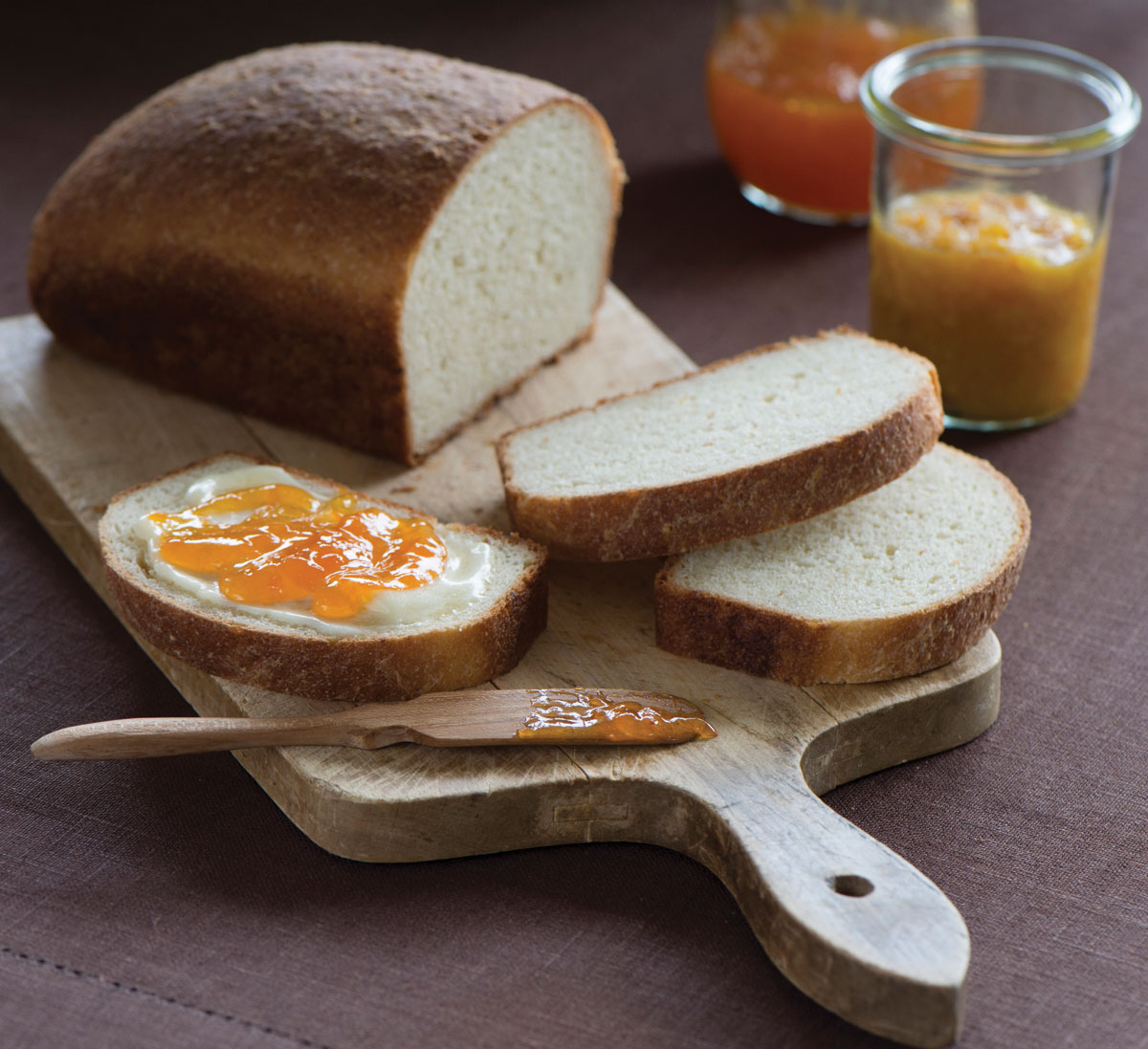
Almond and Apricot Skillet Bread
Kimochdun is a festive yeast bread originating in Afghanistan and enjoyed by Muslims and Jews in Central Asia. Studded with almonds and apricots to represent wealth and good luck, the lightly sweetened bread is prepared by Muslims at the end of Ramadan. Originally kimochdun was baked in a covered pot surrounded by coals. Today it’s baked in an uncovered pot or skillet in an oven. Serve for breakfast, as a snack with tea, or as accompaniment to a plate of soft, mild cheeses.
| 1 package (2-1/4 teaspoons) active dry yeast |
| 1/4 cup (60 ml)warm water (105° to 115°F/40° to 46°C) |
| 2 tablespoons sugar |
| 1-1/4 cups (310 ml) whole milk or goat’s milk |
| 1 tablespoon canola oil |
| 2 teaspoons salt |
| 3 cups (430 g) unbleached all-purpose flour, divided |
| 1 cup (145 g) whole-wheat flour |
| 3/4 cup (115 g) unsulphured dried apricots, coarsely chopped |
| 3/4 cup (3 oz/90 g) raw almonds, coarsely chopped |
Combine the yeast and water in a large mixing bowl or the bowl of a stand mixer fitted with the dough hook and stir to dissolve. Add the sugar and let stand at room temperature until foamy, about 5 minutes.
Add the milk, oil, salt, 2 cups (285 g) of the all-purpose flour, and the whole-wheat flour to the bowl. Mix to combine. Stir or mix in the remaining flour 1/2 cup (75 g) at a time until the dough comes together. Turn out onto a lightly floured surface and form into a ball. Place in an oiled large bowl and turn to coat. Cover with a damp towel or plastic wrap and let rise in a warm place until doubled in volume, 1-1/2 to 2 hours.
Punch the dough down and turn out onto a floured surface. Knead for about 5 minutes, or until smooth. Cover with a dry towel and let rest for 15 minutes. Roll out the dough to a thickness of 1 inch (2.5 cm). Sprinkle with the apricots and almonds. Roll up and form the dough into a ball, pinching the bottom seams closed. Place in an oiled 9-inch (23-cm) Dutch oven or ovenproof skillet. Cover with plastic wrap or a dry towel and let rise until nearly doubled in volume, about 45 minutes.
Preheat the oven to 350°F (180°C). Slash an X in the top of the dough, running from side to side. Bake uncovered in the oven until golden brown, about 45 minutes. Unmold and let cool completely on a wire rack.
Makes 1 (9-inch/23-cm) round loaf
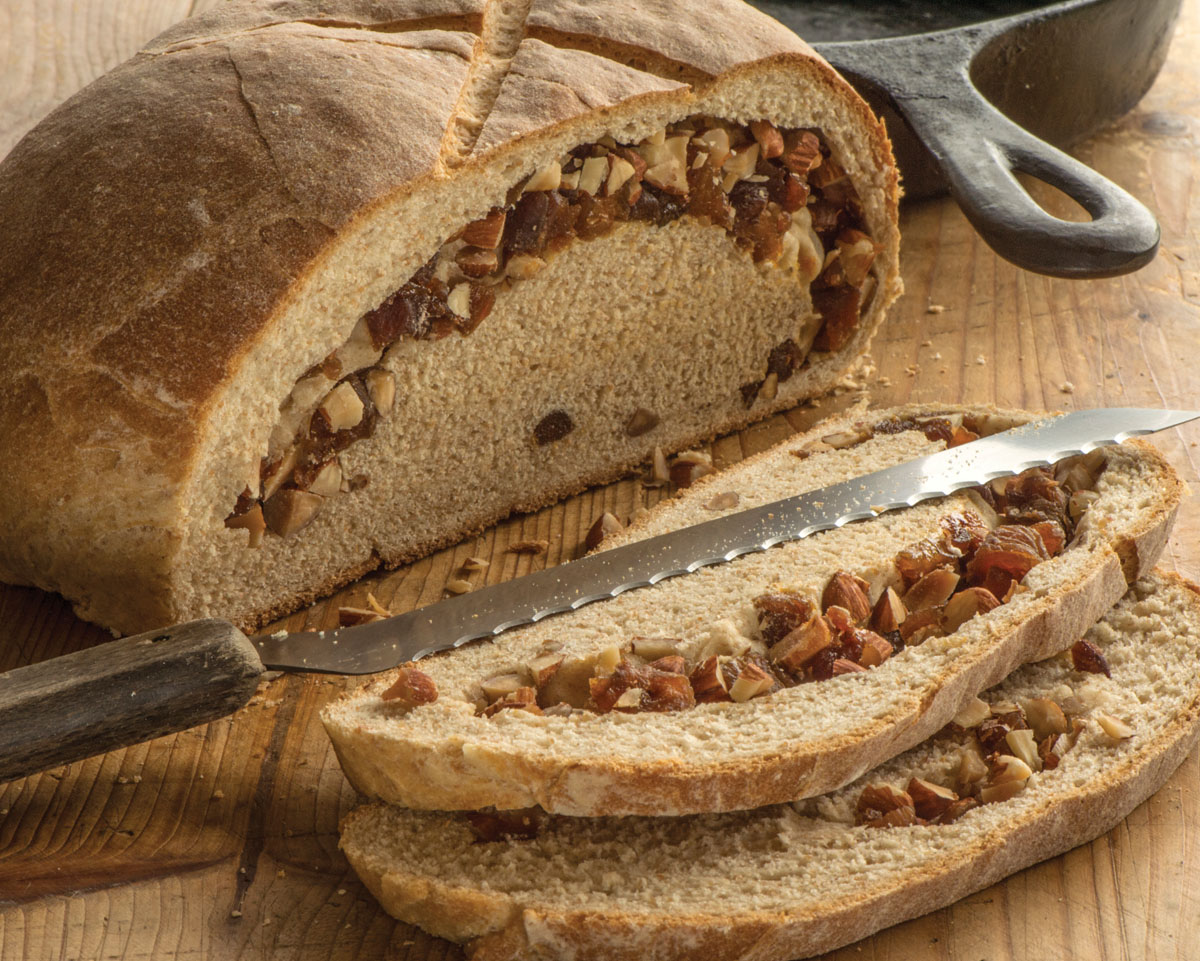
Almond and Cinnamon Kringle
Kringle means “pretzel” in Danish, and a kringle-shaped symbol is an ancient guild sign still used today by Danish bakers. Most bakeries in Denmark have a golden pretzel hanging over their entry. Inside the shops, you will find sweet and savory pretzel-shaped pastries made with puff pastry or yeast dough, sprinkled with salt and seeds or filled with nuts, raisins, almond paste or marzipan. This sweet yeast-dough kringle is a childhood favorite of the Danes, enjoyed with a cup of tea. The dough is easy to prepare, simply requiring an overnight rest before shaping and baking, so be sure to begin the recipe a day in advance. The dough can be shaped into a pretzel or a simple circular ring, as indicated below.
Dough
| 1 package (2-1/4 teaspoons) active dry yeast |
| 1/4 cup (60 ml) warm water (105° to 115°F/40° to 46°C) |
| 2 cups (285 g) unbleached all-purpose flour |
| 1 teaspoon ground cardamom |
| 1/2 teaspoon salt |
| 1/2 cup (115 g) cold unsalted butter, cut into cubes |
| 2 tablespoons sugar |
| 1/2 cup (125 ml) warm whole milk (105° to 115°F/40° to 46°C) |
| 1 large egg, lightly beaten |
Filling
| 3/4 cup (3 oz/90 g) sliced almonds |
| 1/2 cup (145 g) almond paste |
| 1/2 cup (115 g) unsalted butter, softened |
| 1/2 cup (115 g) sugar |
| 1 teaspoon ground cinnamon |
| 1 teaspoon vanilla extract |
Topping
| Sugar, for coating and sprinkling |
| 1 large egg white, lightly beaten |
| 1/4 cup (1 oz/30 g) sliced almonds |
To make the dough, combine the yeast and warm water in a small bowl. Stir to dissolve the yeast, and let stand for 5 minutes, or until foamy. Combine the flour, cardamom, and salt in a large bowl and stir with a whisk to blend. Add the butter. Using your fingertips or a pastry cutter, rub or cut the butter into the flour until it resembles coarse meal. Add the yeast mixture, sugar, milk, and egg. Stir until the dough is smooth (it will be very sticky). Turn the dough out onto a floured surface and form it into a ball. Place the dough in an oiled large bowl and turn to coat. Cover with plastic wrap. Refrigerate for at least 12 or up to 24 hours.
To make the filling, combine all the ingredients in a food processor and pulse until blended.
Line a rimmed baking sheet with parchment paper. Remove the dough from the refrigerator and place on a floured surface. Knead for about 2 minutes, or until smooth. Divide the dough in half. Roll each half into a 10 by 15-inch (25 by 38-cm) rectangle. Spread half of the filling down the center of the rectangle in a 2-inch-wide (5-cm-wide) strip. Overlap the sides of the dough over the filling to make a 4-inch-wide (10-cm-wide) log. Pinch the edges to seal. Sprinkle a little sugar on a work surface and gently roll the log lengthwise to coat with the sugar. Stretch the dough around into a circle and pinch the ends together to seal in a ring. Place seam side down on the prepared baking sheet. Repeat with the remaining dough. Cover with a dry towel and let rise in a warm place until nearly double in volume, about 1 hour.
Preheat the oven to 375°F (190°C). Brush the dough with the egg white. Sprinkle with more sugar and almonds. Bake until golden, about 25 minutes. Remove from the oven, transfer from the pan to wire racks, and let cool. Serve warm or at room temperature.
Makes 2 round kringles, about 8 servings each

Toasted Almond and Orange Biscotti with Golden Raisins
The Italian word biscotti translates to “twice” (bis) “cooked” (cotto), and describes the method for baking these dry and crisp Roman cookies, which are perfect for dunking in coffee or dessert wine. Biscotti usually include almonds, but many variations with chocolate and dried fruit abound. This version uses golden raisins and orange zest, resulting in a sweet and festive cookie.
| 3/4 cup (180 g) sugar |
| 1/2 cup (115 g) unsalted butter, softened |
| 1 large egg |
| 1 tablespoon finely grated orange zest |
| 1 teaspoon vanilla extract |
| 1/2 teaspoon ground cinnamon |
| 2-1/4 cups (330 g) unbleached all-purpose flour |
| 1 teaspoon baking powder |
| 1/2 teaspoon baking soda |
| 1/2 teaspoon salt |
| 3/4 cup (3 oz/90 g) raw almonds, toasted and chopped |
| 1/2 cup (90 g) golden raisins |
Preheat the oven to 350°F (180°C). Line a baking sheet with parchment paper.
Cream the sugar and butter together on medium-high speed in a stand mixer fitted with the paddle attachment. Add the egg, zest, vanilla, and cinnamon and mix to combine on medium speed. Combine the flour, baking powder, baking soda, and salt in a medium bowl. Stir with a whisk to combine. Add to the egg mixture and mix on medium-low speed until combined. Stir in the almonds and raisins.
Divide the dough in half. Form each into a log and flatten to a width of 2 inches (5 cm). Arrange each log on the prepared baking sheet. Bake until light golden and set, about 30 minutes. Remove from the oven and let cool for 20 minutes.
Using a serrated knife, cut into slices 3/4-inch (2-cm) thick. Arrange the slices, cut side down, on the same baking sheet. Return to the oven and bake until golden brown, about 15 minutes. Remove and let cool completely on the racks. Biscotti may be stored in an airtight container for up to 4 days.
Makes 24 biscotti
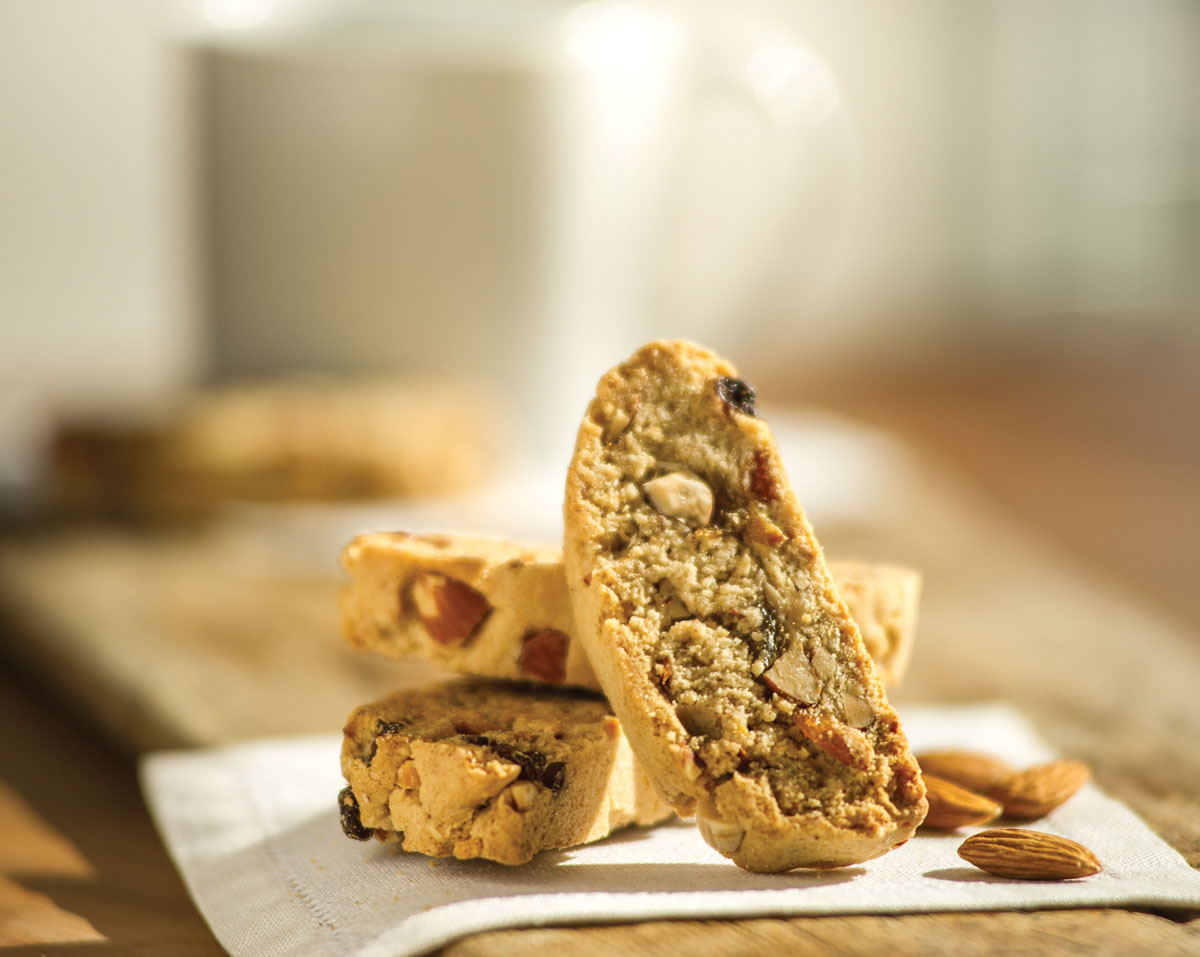
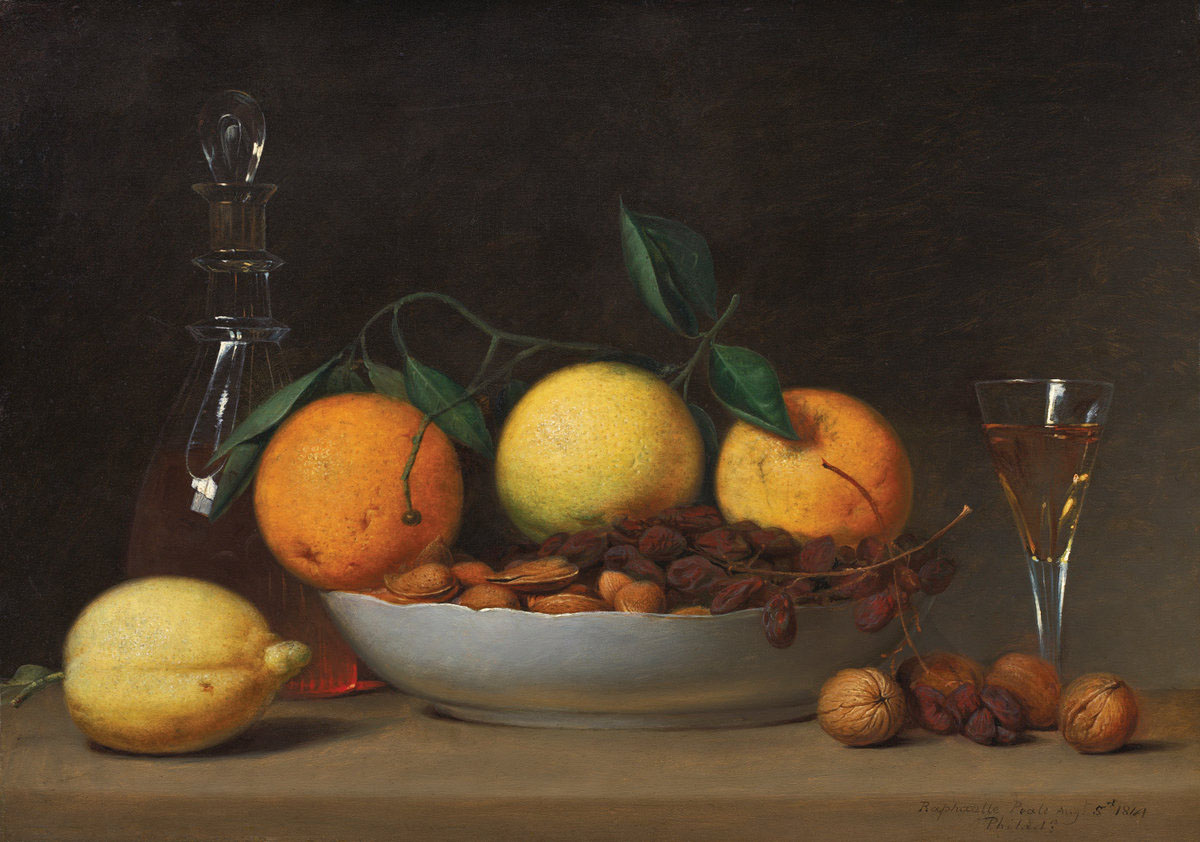
A Dessert, Raphaelle Peale, 1814
Salted Almond Butter Cookies with Chocolate Chunks
Fresh, creamy butter flecked with fleur de sel is a luxurious European tradition, often enjoyed slathered on a fresh baguette. Sea salt loves sugar, balancing sweetness and prodding us to have more In this recipe, flakes of fleur de sel are whipped into the cookie batter, where they remain intact, complementing the golden flavor of the almond butter and studding the dough with tiny, crunchy bursts of salt.
| 1-3/4 cups (255 g) unbleached all-purpose flour |
| 2 teaspoons baking soda |
| 1/2 teaspoon salt |
| 1 cup (225 g) unsalted butter, softened |
| 1 cup (220 g) firmly packed dark brown sugar |
| 3/4 cup (180 g) granulated sugar |
| 1 large egg |
| 1 teaspoon vanilla extract |
| 1 cup (225 g) unsalted creamy almond butter |
| 1 teaspoon fleur de sel or flaky sea salt, plus extra for sprinkling |
| 8 ounces (225 g) dark chocolate (70 to 72 percent), coarsely chopped |
Combine the flour, baking soda, and salt in a medium bowl and stir with a whisk to blend. Cream the butter and sugars together in a stand mixer fitted with the paddle attachment on medium-high speed until light and fluffy. Scrape down the sides and bottom of the bowl. Beat in the egg and vanilla.
Add the almond butter and the 1 teaspoon fleur de sel and mix until smooth. Stir in the flour mixture until just combined. Fold in the chocolate. Cover the bowl with plastic wrap and refrigerate for at least 1 hour or up to 24 hours.
Preheat the oven to 375°F (190°C). Line a baking sheet with parchment paper. Drop the dough onto the baking sheet by rounded tablespoons 2 inches (5 cm) apart. Sprinkle with a few grains of fleur de sel. Bake until lightly golden brown, about 12 minutes. Remove from the oven and transfer the parchment, with cookies, to a wire rack to cool.
Makes 36 to 40 (2-inch/5-cm) cookies)

Almond Florentines
Florentines are classic Christmas cookies with a mysterious provenance. Their name implies an Italian origin, while their method is decidedly French, but there is little question that Florentines are a delicious treat. Toasted almonds, orange, and caramel weave together to form a lacy cookie that is drizzled with dark chocolate. No wonder both countries are happy to call this recipe their own.
| 1-1/4 cups (5 oz/145 g) sliced almonds, lightly toasted |
| 1/4 cup (45 g) unbleached all-purpose flour |
| Finely grated zest of 1 orange, about 1 tablespoon |
| 1/2 teaspoon sea salt |
| 1/2 cup (115 g) granulated sugar |
| 1/4 cup (60 g) firmly packed light brown sugar |
| 1/4 cup (60 ml) heavy cream |
| 4 tablespoons (60 g) unsalted butter |
| 3-1/2 ounces (105 g) dark chocolate, chopped |
Preheat the oven to 350°F (180°C). Line a baking sheet with parchment paper.
Coarsely chop 3/4 cup (90 g) of the almonds. Place in a medium bowl. Add the remaining almonds, flour, orange zest, and salt. Mix with a fork to combine.
Place the sugars, cream, and butter in a medium saucepan. Cook over medium heat, stirring constantly, until the sugar dissolves and the butter melts. Increase the heat to high. Bring to a boil, then remove from the heat and pour over the almonds. Stir to thoroughly combine.
Drop spoonfuls of batter 3 inches (7.5 cm) apart onto the prepared baking sheet (they will spread as they bake). Bake one baking sheet at a time, rotating the pan once or twice to ensure even cooking, for 10 to 12 minutes, or until the cookies are golden brown. Remove from the oven and let cool on the pan on a wire rack for 5 minutes. Using a thin spatula, transfer the cookies to wire racks to let cool completely.
Melt the chocolate in a double boiler over barely simmering water, stirring occasionally until smooth. Dip a fork in the chocolate and drizzle the chocolate over the cookies. Allow the chocolate to set before serving.
Makes about 20 (4-inch/10-cm) cookies

Pear and Almond Frangipane Tart
If you’ve enjoyed French or Italian desserts, chances are you’ve tasted frangipane, an almond pastry cream that’s used as a filling for tarts, cakes, and pastries. In this rustic and aromatic tart, frangipane forms a rich base for pears. The dough is pressed into the tart pan without rolling, resulting in a cookie-like shell. For best results, choose Anjou or Bosc pears, which hold their shape while baking. The tart may be prepared up to a day in advance but is best on the day of preparation. Serve with whipped cream.
Pastry Shell
| 1-1/2 cups (225 g) unbleached all-purpose flour |
| 1/2 cup (115 g) sugar |
| 1/2 teaspoon salt |
| 1/2 cup (115 g) cold unsalted butter, cut into 1/2-inch (12-mm) cubes |
| 1 large egg yolk |
| 2 to 3 tablespoons ice water |
Filling
| 4 to 5 ripe but firm Anjou or Bosc pears |
| Juice of 1/2 lemon |
| 2/3 cup (145 g) sugar |
| 1/2 cup (115 g) unsalted butter, softened |
| 1 large egg |
| 1 large egg yolk |
| 7/8 cup (3-1/2 oz/105 g) raw almonds, finely ground |
| 2 tablespoons all-purpose flour |
| 2 tablespoons pear brandy |
| 1 teaspoon vanilla extract |
| 1/2 teaspoon almond extract |
Glaze
| 1/2 cup (145 g) apricot preserves |
| 1 tablespoon water |
To make the pastry shell, butter a 9-inch (23-cm) tart pan. Combine the flour, sugar, and salt in a food processor. Pulse to combine. Add the butter and pulse until the dough resembles coarse meal. Add the egg yolk and pulse just until moist clumps form. Transfer the dough to a bowl. Add 2 tablespoons water and mix with a fork until the dough begins to stick together. If necessary, add 1 more tablespoon water. Turn the dough into the tart pan. Gently press evenly over the bottom and up the sides without overworking the dough. Refrigerate for 1 hour.
Preheat the oven to 375°F (190°C). Butter a piece of aluminum foil and press, buttered side down, into the tart shell, making sure you fit it into the sides. Bake until lightly browned, about 25 minutes.
To make the filling, peel and halve the pears lengthwise. Scoop out the core and cut out the stem with a paring knife. Thinly slice each pear half crosswise, keeping the halves intact. Lightly sprinkle with lemon juice; set aside. Cream the sugar and butter together in a large bowl until light and fluffy. Beat in the egg and egg yolk. Stir in the almonds, flour, brandy, vanilla, and almond extract until just combined. Do not overmix. Spread the filling in the bottom of the prebaked pastry shell. Arrange each pear half over the filling in a spoke pattern, beginning in the center with the narrow end of each pear, slightly fanning out the slices and gently pressing them into the filling. Bake until the filling is firm and golden, 45 minutes to 1 hour. (If the crust browns before the center is set, place a foil collar around the rim of the crust to prevent burning). Remove the tart from the oven and transfer to a wire rack to cool in the pan.
While the tart is baking, make the glaze: Heat the preserves and water in a small saucepan over medium heat, stirring once or twice, until liquefied. Strain through a fine-mesh sieve.
Brush the warm tart with the glaze. As the tart cools, the glaze will set. To serve, remove the sides of the pan, cut the tart into wedges, and serve slightly warm or at room temperature with whipped cream if desired.
Makes 1 (9-inch/23-cm) tart; serves 8 to 10

Lemon Semolina and Almond Cake with Olive Oil and Honey
Namoura is the Lebanese name for this luscious cake, which combines the Middle Eastern flavors of honey, olive oil, and lemon with a crowning touch of almonds. The dry baked cake will soak up the syrup like a sponge, resulting in a moist and sticky treat to serve with tea.
| 3/4 cup (180 g) sugar |
| 3/4 cup (175 ml) extra virgin olive oil |
| 1/2 cup (125 ml) whole milk |
| 4 large eggs |
| 2 teaspoons finely grated lemon zest |
| 1-1/2 cups (225 g) semolina flour |
| 1/2 cup (60 g) almond flour |
| 2 teaspoons baking powder |
| 1 teaspoon baking soda |
| 3/4 teaspoon kosher salt |
Syrup
| 1/2 cup (115 g) sugar |
| 1/3 cup (75 ml) fresh lemon juice |
| 1/4 cup (90 g) honey |
| Sliced almonds, for decorating |
Preheat the oven to 350°F (180°C). Oil an 8-inch (20-cm) square baking pan. Line the bottom with parchment paper and oil the paper.
Whisk the sugar, olive oil, and milk together in a large bowl. Add the eggs and lemon zest and whisk to combine. Combine the flours, baking powder, baking soda, and salt together in a medium bowl. Stir with a whisk to blend. Add to the wet ingredients and whisk until smooth. Pour into the prepared pan. (The batter will be very thin).
Bake in the oven until the top is set and golden and a skewer inserted in the center comes out clean, about 50 minutes. Remove from the oven and let cool slightly in the pan on a wire rack.
While the cake is baking, prepare the syrup. Combine all the syrup ingredients in a small saucepan. Cook over medium heat, whisking to dissolve the sugar. When the syrup comes to a boil, remove from the heat.
While the cake is still warm, cut into 2-inch (5-cm) squares without removing from the pan. Pour the syrup over the cake. Scatter the sliced almonds over the cake. Let cool completely to allow the flavors to develop. Store in an airtight container for up to 3 days.
Makes 1 (8-inch/20-cm) cake; serves 16

Still Life of Grapes, Nuts, Miniature Pears and a Bee, Giovanna Garzoni, c.1630
Chocolate-Amaretto Torte
Torta caprese is a flourless chocolate and almond cake from the Italian island of Capri. The story goes that a local baker forgot to add flour to his batter—with divine results. This recipe amends the original torta caprese by adding a little flour to bind the batter, while fortifying the cake with amaretto-soaked raisins. The finished cake is coated with a dark chocolate glaze and showered with sliced and chopped nuts, producing a rich dessert redolent of almonds.
| 1/2 cup (90 g) golden raisins |
| 1/3 cup (75 ml) amaretto liqueur |
| 2 tablespoons unsweetened cocoa powder |
| 14 ounces (420 g) dark chocolate (70 to 72 percent), chopped |
| 1 cup (225 g) unsalted butter |
| 6 large eggs, separated |
| 1 cup (225 g) sugar |
| 7/8 cup (3-1/2 oz/105 g) raw almonds, toasted and finely ground |
| 1/2 cup (75 g) unbleached all-purpose flour |
| 1 teaspoon vanilla extract |
| 1 teaspoon almond extract |
| 1/2 teaspoon salt |
Glaze
| 8 ounces (225 g) dark chocolate (70 to 72 percent), chopped |
| 1/2 cup (115 g) unsalted butter |
| 1/2 teaspoon almond extract |
| 7/8 cup (3-1/2 oz/105 g) raw almonds, toasted and finely chopped, for garnish |
| 1/4 cup (1 oz/30 g) sliced almonds for garnish |
Combine the raisins and amaretto in a small bowl. Let stand at room temperature for at least 30 minutes.
Preheat the oven to 350°F (180°C). Butter a 10-inch (25-cm) springform pan. Line the bottom with a round of parchment paper and butter the parchment. Coat the bottom and sides with cocoa, tapping out the excess.
Melt the chocolate and butter in a double boiler over barely simmering water, stirring until smooth.
Beat the egg yolks and sugar with an electric mixer on medium-high speed until light in color and thickened, about 3 minutes. Add the chocolate mixture, raisins with amaretto, almonds, flour, vanilla, almond extract, and salt. Stir to combine.
Beat the egg whites in a clean bowl of an electric mixer until they form stiff, glossy peaks. Stir one-fourth of the beaten whites into the chocolate. Gently fold in the remaining egg whites until blended.
Pour into the prepared cake pan. Bake until the top of the cake is just set (it will still be moist in the center), 40 to 45 minutes. Remove from the oven and let cool completely on a wire rack.
While the cake is cooling, prepare the glaze. Melt the chocolate and butter in a double boiler over barely simmering water, stirring until smooth. Stir in the almond extract.
Invert the cake on a plate and remove the sides and bottom of the pan along with the parchment paper. Pour the glaze over the cake, smoothing it with an offset icing spatula. Toss the finely chopped almonds onto the sides of the cake. Top the cake with the sliced almonds. Refrigerate for at least 2 hours or overnight.
Makes 1 (10-inch/25-cm) cake; serves 10 to 12
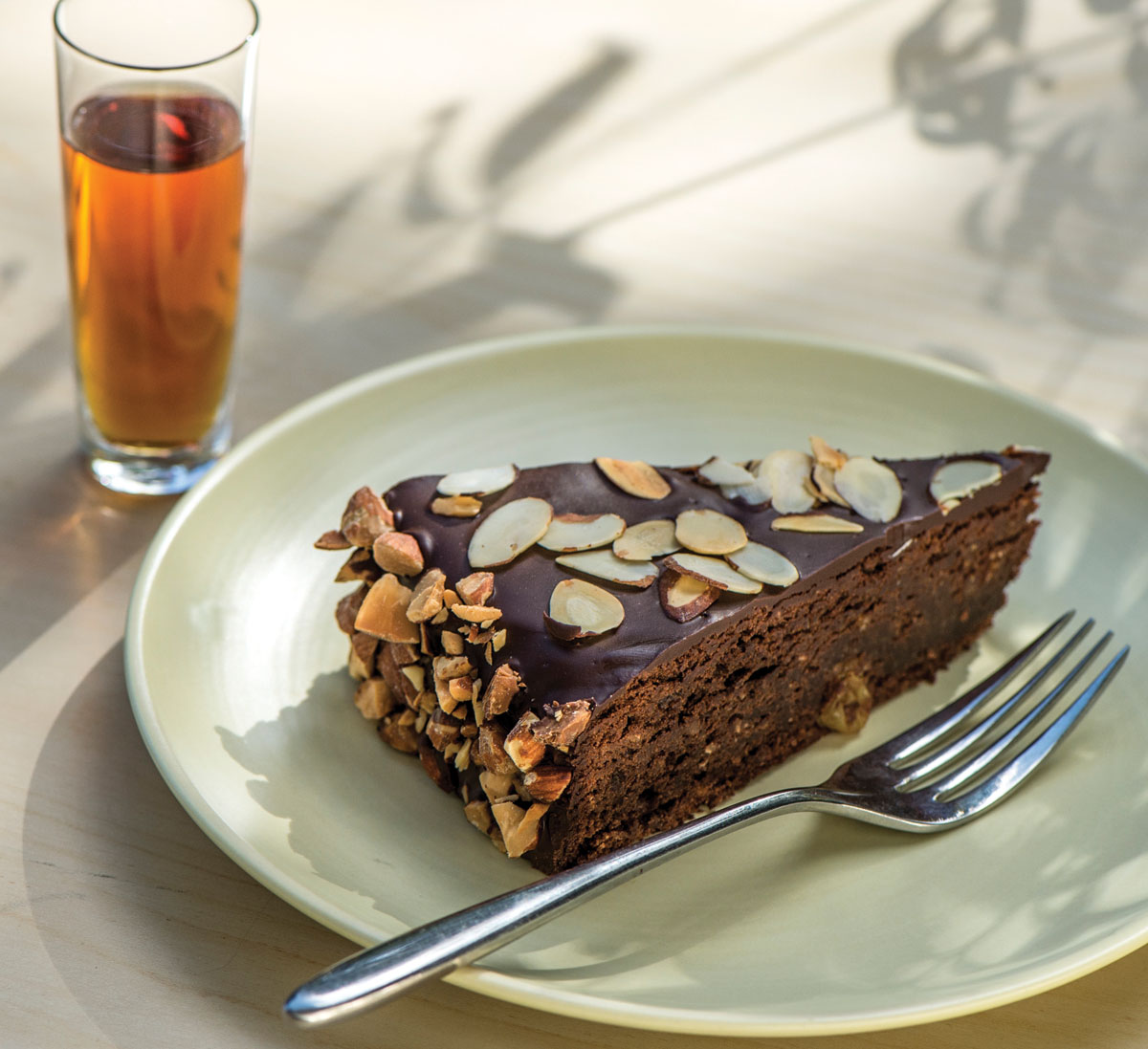

Almond-Fig Tea Cakes
Brown butter adds an extra-nutty richness to these luscious tea cakes fragrant with almond. If fresh figs are not available, dried figs may be substituted. Alternatively, top each cake with 1 or 2 fresh raspberries in place of a fig slice.
| 3/4 cup (180 g) unsalted butter |
| 1-1/2 cups (180 g) confectioners’ sugar, sifted, plus extra for dusting |
| 3/4 cup (60 g) almond flour |
| 1/2 cup (75 g) unbleached all-purpose flour |
| 1/4 teaspoon salt |
| 5 large egg whites |
| 1-1/2 teaspoons almond extract |
| 8 small ripe figs, stemmed and sliced crosswise in thirds, or 12 small dried figs, halved lengthwise |
Preheat the oven to 375°F (190°C). Melt the butter in a small saucepan over medium-low heat until fragrant and lightly browned, about 5 minutes. (Watch it carefully, because it can quickly change from brown to burnt.) Strain through a fine-mesh sieve into a heatproof bowl. Let cool slightly. Pour the clear browned butter into a small pitcher and discard the brown solids on the bottom of the bowl.
Combine the 1-1/2 cups (180 g) sugar, the almond flour, all-purpose flour, and salt in the bowl of a stand mixer fitted with the whisk attachment. Mix to blend. Add the egg whites and mix until just combined. Add the browned butter and the almond extract. Mix until very smooth. Use now, or cover and refrigerate for up to 3 days.
Butter 24 mini muffin cups. Divide the batter evenly among the cups and top each with a fig slice. Bake until golden brown and just cooked through, 15 to 18 minutes. Let cool in pan on a wire rack for 10 minutes. Unmold onto wire racks and let cool completely. Serve dusted with confectioners’ sugar.
Makes 24 (11/2-inch/4-cm) tea cakes

Aaron with Blossoming Almond Rod Before the Ark of the Covenant, c.1360
Almond Semifreddo and Port Wine–Poached Figs with Almond Praline
Semifreddo, which means “half-frozen,” is a light and airy Italian cream dessert that does not require an ice cream machine to make. Almonds and orange zest fleck this semifreddo, which is drizzled with a richly spiced fig compote and topped with shards of praline. If you can’t find fresh figs, dried figs may be substituted. The semifreddo should be served within 24 hours.
Semifreddo
| 2/3 cup (2-1/2 oz/75 g) raw almonds, toasted |
| 1/2 cup (115 g) sugar, divided |
| 1/2 teaspoon finely grated orange zest |
| 1/4 teaspoon sea salt |
| 3 large egg whites, at room temperature* |
| 1 cup (250 ml) cold heavy cream |
| 1/2 teaspoon almond extract, or 2 teaspoons amaretto liqueur |
| 1/4 teaspoon vanilla extract |
Figs
| 1 cup (250 ml) port or red wine |
| 1/2 cup (125 ml) balsamic vinegar |
| 1/4 cup (60 ml) fresh orange juice |
| 2 tablespoons honey |
| 1 cinnamon stick |
| 2 whole cloves |
| 1/2 teaspoon black peppercorns |
| 16 medium-ripe fresh figs or large, plump dried figs, stemmed and halved lengthwise |
Praline
| 1/2 cup (115 g) sugar |
| 1/2 cup (2 oz/60 g) sliced almonds, lightly toasted |
| 1/2 teaspoon salt |
*Note: This recipe contains raw eggs.
To make the semifreddo, line a 9 by 5-inch (23 by 13-cm) loaf pan with plastic wrap, leaving a 3-inch (7.5-cm) overhang on all sides.
Place the almonds and 1/4 cup (60 g) of the sugar in a food processor. Pulse until finely ground. Add the orange zest and salt; pulse to blend.
Beat the egg whites with an electric mixer on high speed until they begin to hold soft peaks. Add the remaining 1/4 cup (60 g) sugar, 1 tablespoon at a time, and beat until stiff, glossy peaks form.
In a deep bowl, beat the cream and almond and vanilla extracts on high speed until soft peaks form. Gently fold the beaten whites into the cream until blended. Gently fold the almonds into the cream mixture until evenly distributed. Spoon into the prepared baking dish and smooth the top. Cover with plastic and freeze for at least 8 hours or overnight.
To prepare the figs, combine all of the ingredients except the figs in a heavy medium saucepan and bring to a boil over medium-high heat. Cook until the liquid is reduced by two-thirds and syrupy in consistency, 10 to 12 minutes. Strain through a fine-mesh sieve and return to the pan. Add the figs and gently stir to coat. If using fresh figs, simmer for 5 minutes over medium-low heat, stirring occasionally. If using dried figs, simmer until softened, about 10 minutes. Remove from the heat and let cool completely.
To make the praline, line a baking sheet with parchment paper. Heat the sugar in a small, heavy saucepan over medium heat until it melts, stirring occasionally with a wooden spoon. Continue to cook, stirring constantly, until the sugar turns amber in color. Add the almonds and salt and stir quickly to coat. Pour onto the prepared baking sheet and spread into a thin layer with a wet spatula. Do not touch with your fingers. Let cool completely. Break into 1-1/2-inch (4-cm) pieces.
To assemble the dessert, grasp the sides of the plastic liner and gently lift the semifreddo from the loaf pan onto a cutting board. Carefully slide the liner out from under the semifreddo and discard. Cut the loaf into 3/4-inch (2-cm) slices and place a slice in each of 8 to 10 shallow soup bowls. Spoon the figs and syrup over the semifreddo. Garnish with praline pieces and serve immediately.
Serves 8 to 10

Moroccan Rice Pudding
Rice pudding is a standard dessert in many European and Middle Eastern cultures. This recipe takes inspiration from the Moroccan roz bil halib, with the addition of raisins and honey. Typically, the rice is first boiled in water, then simmered in milk. In this version, almond milk is substituted for the water. Orange flower water, which may be purchased in Middle Eastern markets or the international section of your super-market, replaces the traditional rose water in this variation. Cointreau, or another orange-flavored liqueur, may be substituted for the flower water for a spirited version.
| 1/2 cup (90 g) raisins |
| 2 tablespoons orange flower water |
| 1-1/4 cups (310 ml) unsweetened almond milk |
| 2 tablespoons sugar |
| 1 cup (210 g) Arborio rice |
| 4-1/2 cups (1.1l) whole milk |
| 2 tablespoons unsalted butter |
| 1 (3-inch/7.5-cm) cinnamon stick |
| 1 teaspoon almond extract |
| 1/2 teaspoon salt |
| 1/3 cup (1-1/2 oz/45 g) raw almonds, toasted and coarsely chopped |
| Honey, for drizzling |
Combine the raisins and orange flower water in a small bowl. Set aside.
Heat the almond milk and sugar in a large pot, stirring to dissolve the sugar. Add the rice. Bring to a boil, then reduce the heat to low. Cover and simmer until most of the liquid is absorbed.
Add 3 cups (750 ml) of the whole milk, the butter, cinnamon stick, almond extract, and salt to the rice. Simmer over medium-low heat, stirring frequently to prevent sticking, until the rice is thickened. Add the remaining milk, 1/2 cup (125 ml) at a time, stirring until the milk is absorbed before adding more milk each time. The rice pudding should be thickened but not stiff. The cooking process will take approximately 45 minutes. Remove from the heat and discard the cinnamon stick.
Spoon the pudding into 4 bowls. Sprinkle with the raisins and almonds and drizzle with a little honey. Serve warm or chilled.
Serves 4

Plum Trifle with Amaretti
Sumptuous trifles are a British tradition: billowy parfaits of fruit and cream layered with sponge cake, ladyfingers, or cookies. This trifle layers crisp amaretti cookies, the Italian version of almond macaroons, with an almond-infused plum compote and ripples of custard cream. Store-bought amaretti may be substituted for homemade.
Amaretti
| 1 cup (225 g) granulated sugar |
| 8 ounces (225 g) almond paste |
| 3 large egg whites |
| Pearl sugar (optional) |
Compote
| 2 pounds (900 g) plums, halved and pitted |
| 1/2 cup (115 g) granulated sugar |
| 1 teaspoon almond extract |
| 1/2 teaspoon ground cinnamon |
Custard Cream and Topping
| 2 large egg yolks |
| 4 tablespoons (60 g) granulated sugar |
| 1/2 vanilla bean, split lengthwise |
| 1/2 cup (125 ml) whole milk |
| 1-1/2 cups (375 ml) heavy cream |
| 1 tablespoon amaretto liqueur |
To make the amaretti, preheat the oven to 350°F (180°C). Line two baking sheets with parchment paper.
Process the sugar in a food processor until superfine. Add the almond paste and process until finely crumbled. Add the egg whites, one at a time, pulsing after each addition, then process until smooth.
With either a pastry bag or a spoon, pipe or drop 1-inch (2.5-cm) mounds of batter onto the prepared baking sheets. Sprinkle with pearl sugar, if using. Bake until lightly golden and cracked, 12 to 15 minutes. Remove from the oven and let cool completely on wire racks. (Makes about 3 dozen cookies.)
To make the compote, cut each plum half into 1/2-inch-thick (12-mm-thick) slices. Place in a large saucepan with the sugar, almond extract, and cinnamon.
Cook over medium heat, stirring, until the sugar dissolves. Reduce the heat to medium-low. Cook, stirring occasionally, until the plums are soft and syrupy, about 10 minutes. Remove from the heat and let cool completely.
To make the custard cream, whisk the egg yolks and 2 tablespoons of the sugar together in a medium saucepan. In another medium saucepan, scrape the vanilla seeds into the milk and add the pods to the pan. Cook over medium-low heat until bubbles form around the edges of the pan. Stir 2 tablespoons of the milk into the eggs. Slowly add the remaining milk, stirring constantly. Heat the milk mixture over medium heat, stirring constantly with a wooden spoon, until the custard thickens to the consistency of heavy cream and coats the wooden spoon, about 4 minutes. Do not let the custard boil. Remove from the heat and strain through a fine-meshed sieve into a bowl. Set aside and let cool completely.
Beat the heavy cream on high speed with an electric mixer until traces of the beaters are visible in the cream. Add the remaining 2 tablespoons sugar and the amaretto. Beat until soft peaks form. Gently fold half of the whipped cream into the custard.
To assemble the trifle, spoon a thin layer of the compote into the bottom of a large glass serving bowl or 8 individual glass goblets. Crumble a layer of amaretti over the compote. Cover with half of the custard cream. Top with half of the remaining compote. Crumble another layer of amaretti over the compote. Cover with the remaining custard cream. Top with the remaining compote. Crumble a final layer of amaretti over the compote. Spoon the reserved whipped cream over the top of the trifle. Dot the top of the trifle with crumbled amaretti.
Serve immediately, or refrigerate for up to 4 hours. The longer the trifle sits, the softer it will become.
Serves 8


Adoration of the Magi, Bernardino Luini, c.1525
Chocolate Almond Bark with Raisins and Chile
This easy, no-bake dessert is perfect for the holidays. Studded with almonds and raisins and spiced with an Aztec blend of chili powder, cinnamon, and cayenne, it will liven up any dessert table or gift basket. The balance of heat, spice, and salt is addictive, so consider making a double batch. Choose the best quality of chocolate you can find.
| 12 ounces (350 g) dark chocolate (70 to 72 percent), chopped |
| 3/4 teaspoon ancho chile powder |
| 1/2 teaspoon ground cinnamon |
| 1/4 teaspoon cayenne pepper, or to taste |
| 1 cup (4 oz/115 g) raw almonds, toasted and coarsely chopped |
| 3/4 cup (115 g) raisins |
| Sea salt (optional) |
Line a baking sheet with parchment paper.
Melt two-thirds (8 oz/225 g) of the chocolate in the bowl of a double boiler, stirring frequently until smooth. Remove from the heat and add the remaining chocolate. Stir until all the chocolate is melted and smooth. Stir in the chile powder, cinnamon, and cayenne. Add half of the almonds and half of the raisins to the chocolate.
Pour the chocolate onto the baking sheet, smoothing it out in a thin, even layer with a spatula. Sprinkle with the remaining nuts and raisins, gently pressing them into the chocolate. Sprinkle with sea salt, if using.
Refrigerate until firm, about 30 minutes. Break into 1-1/2-inch (4-cm) pieces to serve. Store in an airtight container in the refrigerator for up to 2 weeks.
Makes about 1 pound (450 g)
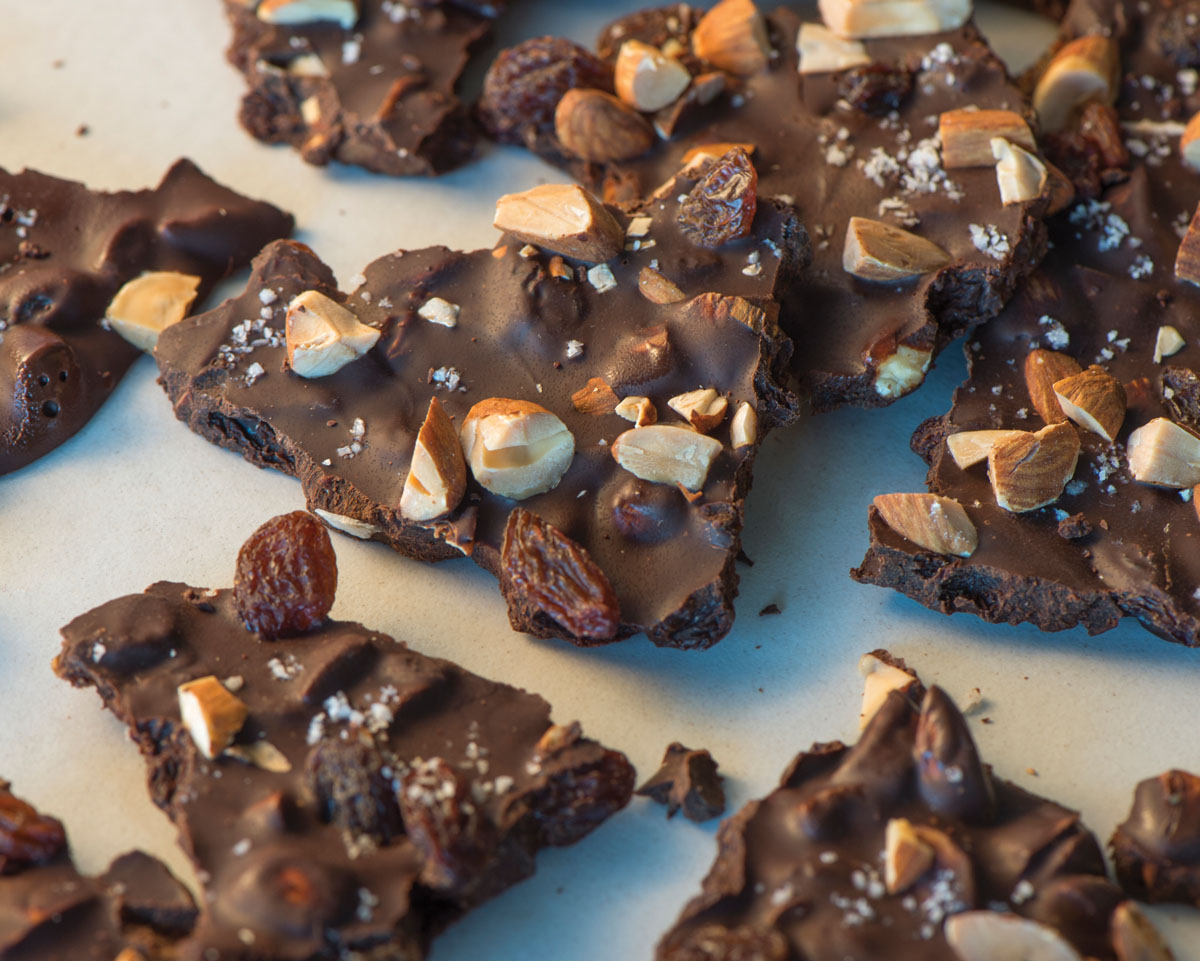
Almond Granita with Raspberries
As if we needed another reason to love Italy, breakfasts there often include a sweet cookie, cake, or frozen granita. In Sicily, almond granita is served for breakfast in a brioche. We call this recipe “dessert” and omit the brioche, while adding raspberries in syrup for a sweet treat. Be sure that the raspberry syrup is well chilled before serving; otherwise it will melt the granita.
Granita
| 3 cups (750 ml) unsweetened almond milk |
| 1/3 cup (90 g) sugar |
| 1/4 cup (75 g) almond paste |
| 1/4 teaspoon almond extract, or to taste |
Raspberries in Syrup
| 1/3 cup (90 g) sugar |
| 1/3 cup (75 ml) water |
| 1/2 teaspoon ground cardamom |
| 2 cups (225 g) fresh raspberries |
| 1/4 cup (1 oz/30 g) sliced almonds, toasted |
To make the granita, process the almond milk, sugar, almond paste, and almond extract in a blender or food processor until smooth. Strain through a fine-mesh sieve into an 8-inch (20-cm) square metal baking pan. Freeze for 1 hour. Stir with a fork, breaking apart any frozen clumps, and freeze again for 2 hours. Scrape with a fork to break into flakes. Serve immediately, or freeze for up to 3 days. Before serving, scrape with a fork.
To make the berries in syrup, combine the sugar, water, and cardamom in a small saucepan. Bring to a boil over medium-high heat, stirring until the sugar is dissolved. Remove from the heat and stir in the raspberries. Let cool completely. The syrup may be prepared up to 6 hours in advance. Cover and refrigerate until use.
To serve, divide the granita among 6 bowls. Spoon some of the raspberries and a little syrup over the granita. Garnish with sliced almonds.
Serves 6


